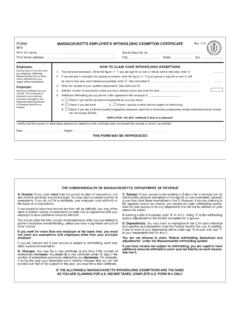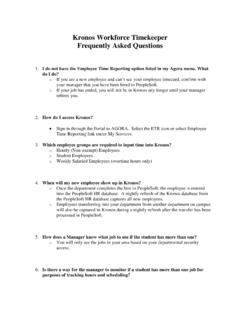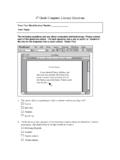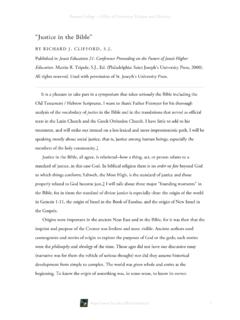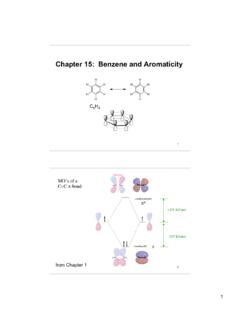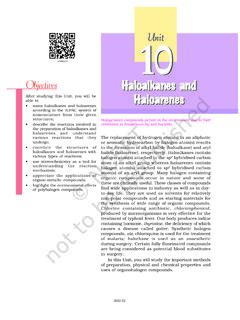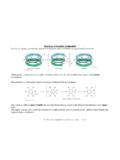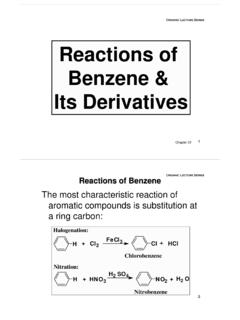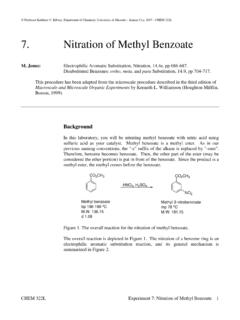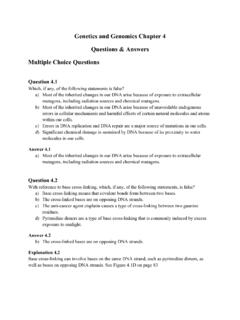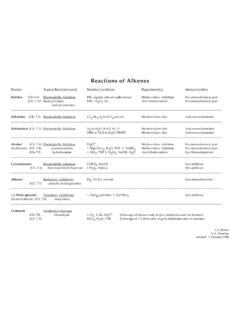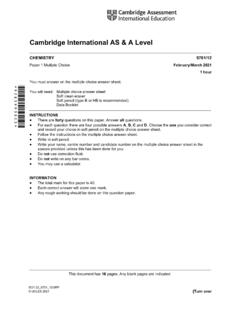Transcription of Experiment 11: Bromination of Stilbene
1 1. Experiment 11: Bromination of Stilbene In the Experiment entitled Steam Distillation, you demonstrated that eugenol has one or more carbon-carbon double bonds by reacting it with bromine, Br2, and observing the discharge of the reddish-brown color of bromine as each drop reacted with the double bond in eugenol. At that time, you were not asked to specify the structure of the product. Now that you have studied the mechanism of the addition of bromine to alkenes in lecture, as well as stereochemistry and optical isomerism, you are equipped to explore some of the more subtle aspects of this addition reaction. In today's Experiment , you will carry out the addition of bromine to the trans and cis isomers of 1,2-diphenylethene, more commonly known as trans- and cis- Stilbene .
2 Trans- Stilbene cis- Stilbene H. H. H H. 122-124 C 82-84 C. density g/mL density g/mL. g/mol g/mol In both cases, the nucleophilic double bond undergoes an electrophilic addition reaction by the bromine reagent which proceeds via a cyclic bromonium ion. The addition of bromine begins at one side of the double bond (either side is equally likely, but only one option is drawn) and is followed by attack of bromide ion on the bromonium ion (again, attack could occur at either carbon since the ion is symmetric, but only one option is drawn). The result is a trans dibromide, as shown in the equation below: Br Br+. C C Br2 C C C C. Br . Br Since the cis and trans isomers of Stilbene have different geometries, it follows that upon reaction with bromine they give rise to stereoisomeric bromonium ions and, eventually, products that differ only by their stereochemistry.
3 The product of this reaction, 1,2-dibromo-1,2-diphenylethane, has two stereogenic centers, which normally leads one to predict four (2n = 22 in this case) possible stereoisomers ( , four optical isomers). However, there are only three possible isomers in the case of 1,2-dibromo-1,2-diphenylethane since one, the so-called meso isomer, is 2. superimposable on its mirror image. The meso isomer does contain stereogenic centers, but since it is superimposable on its mirror image, it does not rotate the plane of polarized light. The other isomeric product is a racemic mixture (often called ( ) or a d,l pair). A. racemic mixture contains an exactly 50:50 mixture of the two molecules that are non- superimposable mirror images of each other (racemic mixtures also do not rotate the plane of polarized light).
4 The racemic mixture is a mixture of two enantiomers, both of which are diastereomers of the meso isomer. Like all diastereomers, the racemic mixture and the meso isomer have different physical properties. Most notable is that the melting points differ markedly, with the racemic mixture melting at 114 and the meso compound melting in the range 241-243 . You will carry out the Bromination reactions of both cis- and trans- Stilbene , and from the melting points of the products, you will be able to determine whether the racemic mixture or the meso compound is formed. In these two Bromination reactions, pyridinium tribromide will be used as the source of bromine. + Br Br N N. Br Br Br Br H H. pyridinium tribomide This solid reagent is safer and easier to handle than elemental bromine, which is a highly corrosive liquid.
5 Procedure Heat approximately 300 mL of water to the boiling point on a hot plate. No temperature probe is needed. Remember to turn the Temp knob until the set temp on the bottom of the display reads 300. Bromination of cis- Stilbene Note: Slightly less cis- Stilbene is used in this Experiment than trans- Stilbene due to the relative cost of the two isomers. The difference in cost reflects the relative difficulty of synthesizing each isomer. Since the trans isomer is the more stable, it is easier to make and costs less. The supplier from whom we buy the stilbenes charges $ per gram for the cis isomer but only $ per gram for the trans isomer. 1. Using a syringe attached to a Pasteur pipet, measure mL of cis- Stilbene and place it in an 18 x 150 mm test tube.
6 2. Add 3 mL of glacial acetic acid and agitate the test tube to mix the compounds. 3. Cool the test tube on ice and add g of pyridinium tribromide. Wash down the sides of the test tube with an additional 3 mL of glacial acetic acid. 3. 4. Place the test tube in the boiling water bath and stir with a stirring rod until the orange- yellow color of the pyridinium tribromide fades to yellow (about 5-10 minutes). 5. Cool the test tube to approximately 40-50 in a water bath. Add 6 mL of water and place the test tube on ice for about 15 minutes. 6. Collect the solid product in a Hirsch funnel by vacuum filtration, wash it with water and allow it to air dry. Obtain a melting point so that you can determine whether the racemic mixture or meso compound is formed.
7 Next week, you will re-measure the melting point and weigh the product when it has dried. Bromination of trans- Stilbene 1. Weigh g of trans- Stilbene and place it in an 18 x 150 mm test tube. 2. Add 4 mL of glacial acetic acid and heat the test tube in a water bath to dissolve the solid. Stir with a glass rod until it completely dissolves. 3. Add g of pyridinium tribromide. Wash down the sides of the test tube with an additional 4 mL of glacial acetic acid. 4. Place the test tube in the boiling water bath and stir occasionally with a stirring rod for 10 minutes. 5. Cool the test tube to room temperature. 6. Collect the solid product by vacuum filtration in a B chner funnel. Wash it with two or three small portions (3 mL or less) of methanol until the orange color is removed.
8 Allow the product to air dry. Obtain a melting point so that you can determine whether the racemic mixture or meso compound is formed. Next week, you will re-measure the melting point and weigh the product when it has dried. Place all waste from these reactions into the Laboratory Byproducts jar labeled Halogenated Hydrocarbons. Iodination: A Dramatic Demonstration of Ring Strain As we moved around, Farnon's manner became more and more animated. His eyes glittered and he talked rapidly. Often, he reached up and caressed a Winchester on its shelf; or he would lift out a horse ball or an electuary from its box, give it a friendly pat and replace it with tenderness. Look at this stuff, Herriot, he shouted without warning.
9 Adrevan! This is the remedy, par excellence, for red worms in horses. A bit expensive, mind you ten bob a pocket. And these gentian violet pessaries. If you shove one of these into a cow's uterus after a dirty cleansing, it turns the discharges a very pretty colour. Really looks as though it's doing something. And have you seen this trick?'. He placed a few crystals of resublimated iodine on a glass dish and added a drop of turpentine. Nothing happened for a second then a dense cloud of purple smoke rolled heavily to the ceiling. He gave a great bellow of laughter at my startled face. Like witchcraft, isn't it? I use it for wounds in horses' feet. The chemical reaction drives the iodine deep into the tissues.
10 '. It does?'. 4. Well, I don't know, but that's the theory, and anyway, you must admit it looks wonderful. Impresses the toughest client.' . From All Creatures Great and Small by James Herriot Unlike bromine, iodine reacts very slowly or not at all with most alkenes. However, in the case where the reaction results in the release of ring strain, a very rapid and exothermic reaction can result. The major component of turpentine is a-pinene, a bicyclic compound that contains a highly strained four-membered ring. The addition of iodine to the double bond in a-pinene results in the formation of a carbocation. This allows the four-membered ring to expand to a much less strained five-membered ring, as shown in the mechanism pictured below.
